The art of hoshigaki
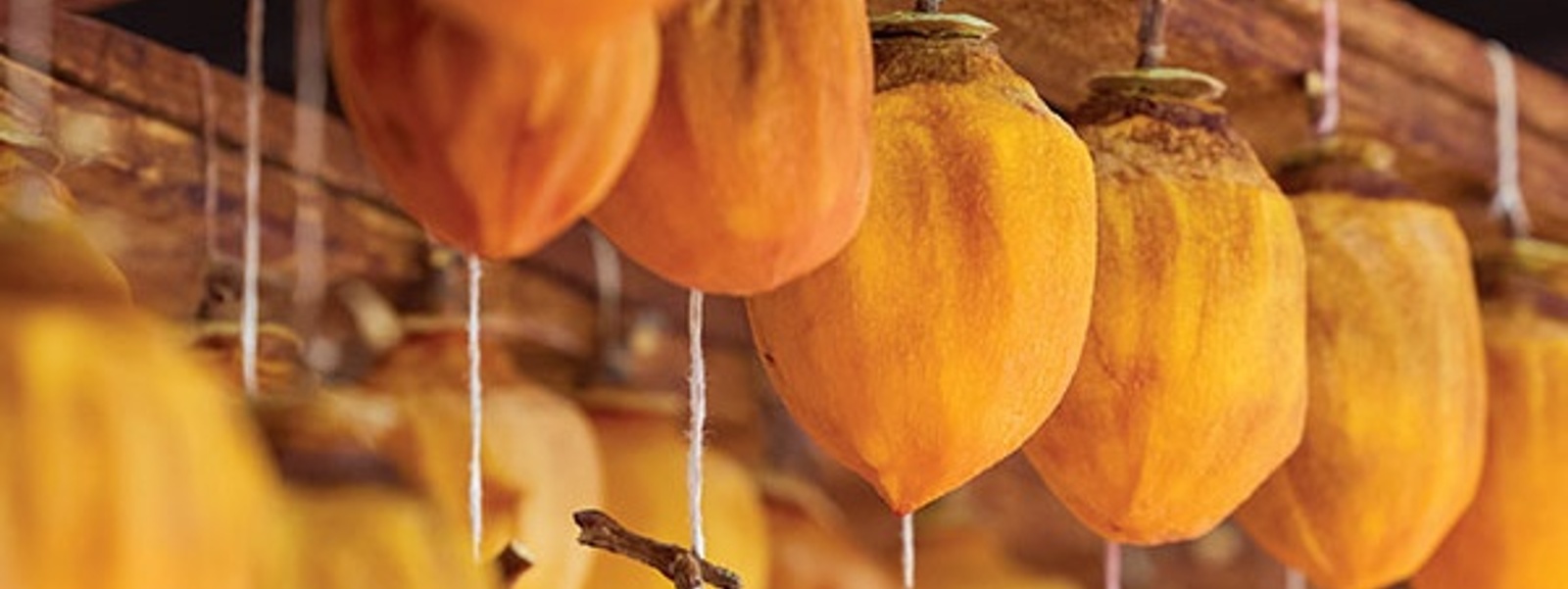
Fall 2024 California Bountiful magazine
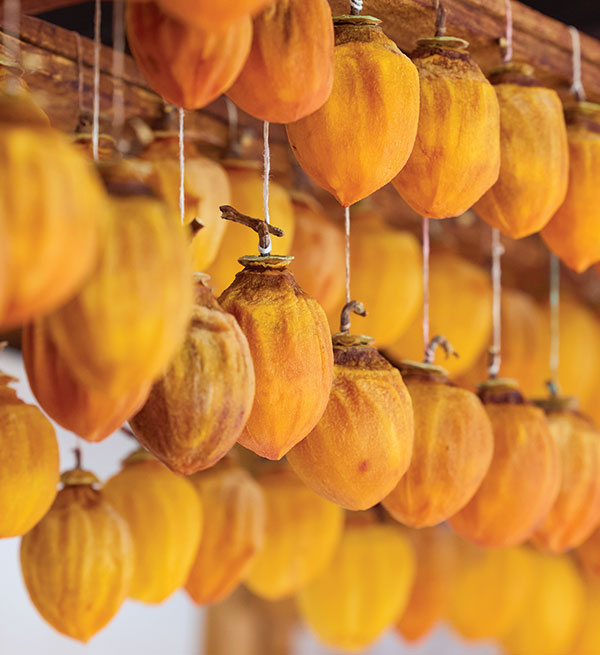
Japanese dried persimmon tradition lives on at Otow Orchard
Story by Linda DuBois
Photos by Fred Greaves
Marilyn Feller was amazed by the sweet burst of flavor the first time she tasted hoshigaki, traditional Japanese dried persimmons.
“It’s been a love affair ever since,” she says.
For years, she’d been regularly purchasing fresh produce from a farmstand at Otow Orchard in Placer County. But she’d never tried its hoshigaki until about 12 years ago when the farm’s owners, Tosh and Chris Kuratomi, suggested she sample some.
She now regularly buys packages of two to four for herself to enjoy and to mail to friends and relatives out of state.
“As I’m exiting their driveway, I’m already digging in,” she acknowledges. “I have to be very careful because I could eat a whole package of four in the blink of an eye. So, I have to judiciously tell myself, ‘OK, you can eat two, but the others you have to put in the freezer.’”
They do freeze well, she says, adding that when thawed, they maintain their original consistency and flavor.
She has two pieces of advice to hoshigaki newcomers: They have a few seeds, so don’t bite down too hard, and be prepared to pay a price that reflects the “hard work and effort” that goes into making them.
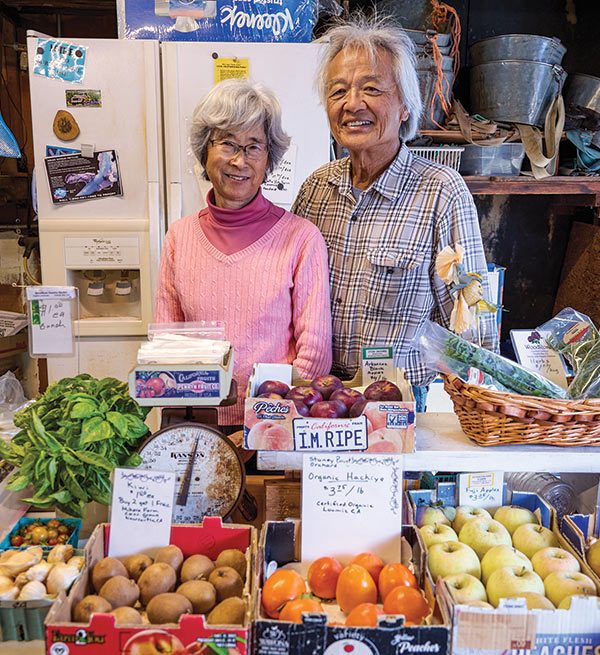
Family legacy
Historians believe people began making hoshigaki—Japanese for “dried persimmon”—in the Heian period (794 to 1185) to preserve the fruit throughout the winter.
They also were used as ornaments in New Year’s decorations and were considered a sign of good luck and longevity.
By the 1800s, hoshigaki was introduced to the United States by Japanese immigrants.
The tradition was passed down through the generations to Chris Kuratomi, whose grandfather, Kitchitaro Kawano, started the family farm in Granite Bay in 1911 after immigrating from Japan in the late 1800s.
Over the years, the 40-acre property northeast of Sacramento, with its orchard, small farmhouse and a vegetable garden, was surrounded by large luxury homes as the rural community evolved into an affluent suburb.
“It’s a family home and land—and we don’t know how to stop,” Chris says with a laugh, explaining why the family continues farming there.
Her mother, Helen Otow, was born and died on the farm and continued to help with the work during her later years before passing away at age 106 in 2022. Now, the regular crew includes Chris and her husband, Tosh, as well as a few other family members and longtime employees.
The farm grows various crops, including loquats, stone fruits and summer vegetables in warm months, pears, apples, jujube, pomegranates, quince and fresh persimmons in autumn and citrus in the cooler months. But its most prized, sought-after item is hoshigaki.
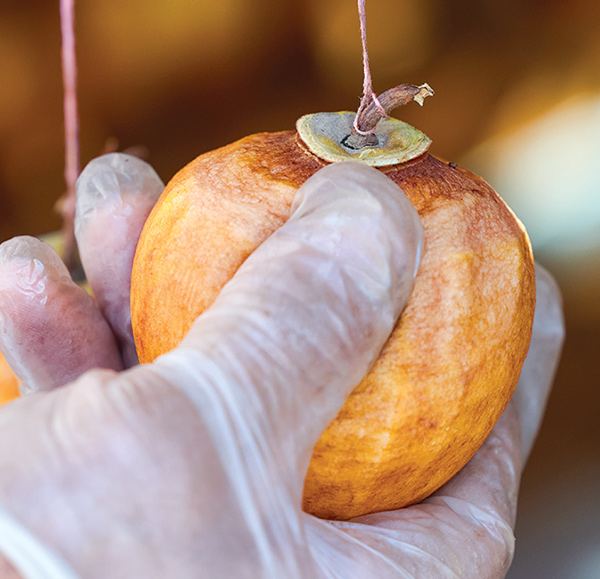
Painstaking process
Tosh Kuratomi explains the meticulous method of creating the perfect hoshigaki.
They pick the persimmons just before the fruit reaches full maturity. Then, they carefully hand peel each one. Peeling makes the fruit permeable so moisture can escape, and the sugar that dissolves on the surface gives the hoshigaki its characteristic white powdery appearance.
Then they cut a short string and tie one persimmon by the stem on each end. They hang the string over a homemade rack, carefully distancing each hanging pair so no fruit touches another. The weight of each persimmon balances out the other, keeping the string in place.
As a fruit dehydrates, the stem shrinks, but the moisture and sugar that’s evaporated cause the string to stiffen and stick to the stem, so it won’t come loose.
They start drying on outdoor racks, under tarps to protect them from rain. Depending on the weather, after four to six days, they are moved indoors where they hang for about a month, often with help from dehumidifiers.
Throughout the drying process, the Kuratomis regularly “massage” the persimmons by gently pressing around the surface of each to keep them a uniform consistency and color.
“If you just dry it, it’s likely to be lumpy and fibrous, and you want it to have more of a jelly donut kind of experience,” Tosh says. “Chris and I are out there every day. We go rack by rack, and a single persimmon may get massaged a couple of times a week.”
Once the drying persimmons are moved inside, the Kuratomis can work late into the night. “Around Thanksgiving and Christmas, we’re here until about 1 in the morning,” he says.
Tosh says they wrap newspapers around the rack legs to deter rats and set fly traps to thwart flying insects. While birds don’t often bother the drying persimmons, they can decimate the persimmons while still on the tree.
“If we see little spots of mold starting, we take vodka and a soft toothbrush and we wipe it and it disappears,” Tosh says.
There’s also the chance some fruit will dry with a blemish or split surface. These, they’ll either sell at a discount or cut into strips and sell as snack packs.
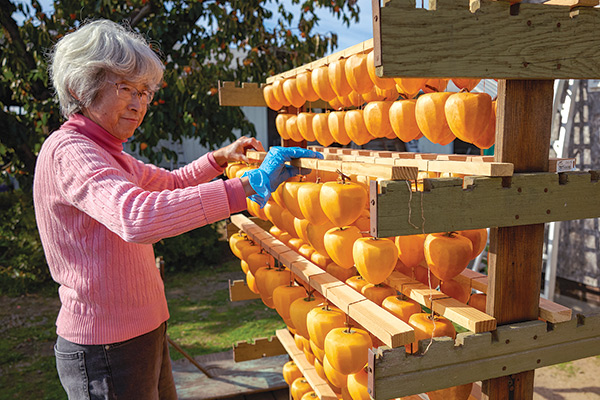
Customer favorite
When the hoshigaki is sufficiently dried, they package and sell it at their farmstand and by mail order. They also try to vacuum seal and freeze enough so they can sell some year-round.
The yield varies each year.
“We might have made as much as 1,500 pounds this past year. I think we peeled around 6,000 pounds (of fresh fruit), and it takes 4 or 5 pounds to make a pound,” Tosh says.
No matter how much they produce, the Kuratomis are never short of customers.
“There’s always been someone asking for these. We didn’t go out and market,” Tosh says.
“There are so many foodies nowadays and there’s something about having that niche product that’s hard to find. It’s $60 a pound if they mail order it, but they want to pay it,” he says, adding they mail up to 800 pounds a season.
Customers are also content to pay the $37 per pound charged at the farmstand.
Yet, it’s still not a profit-making endeavor.
“I would call it a labor of love,” Tosh says, estimating he and Chris make less than $5 per hour. “With the overall operation, we shoot to break even. We live off our retirement.” Both worked for public schools—Tosh as a teacher and Chris as a speech and language specialist.
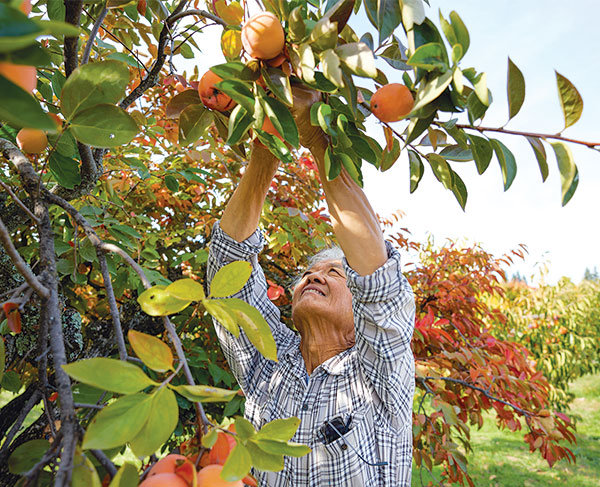
Rewarding venture
Even so, the Kuratomis want to keep the farm going and pass it down to the next generation. Although their three children—including son Toshio and older daughter Maya—have all launched other careers, their daughter and son-in-law, Michie and Jerome Burbano, have committed to taking over the farm when they eventually retire.
In the meantime, what keeps the couple going are the relationships they’ve built over the years. Sometimes customers send pictures of their families eating the persimmons or notes about how much they enjoyed them.
“Those personal things are really, really special. That’s why my wife won’t quit farming. She says, ‘What about the customers?’ I won’t quit farming because I love driving a tractor,” Tosh says with a laugh.
They also have a passion for sharing the tradition of hoshigaki, advising their fresh persimmon customers on how to make their own and encouraging other persimmon farmers to try it.
“We need to have people get into it instead of just relying on us,” Tosh says. He knows of a couple of other small farmers making hoshigaki, and he tries to send potential customers their way. “I tell them, ‘There’s a lot of younger guys trying to get into this and you need to give them a shot at it. We don’t need to be hogging the market to ourselves.’”
The right persimmon depends on its purpose
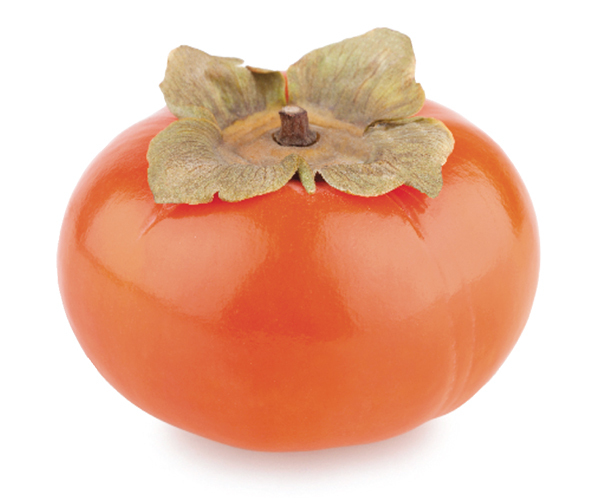
Persimmons are delicious no matter what variety you choose, but to fully enjoy them, you’ll need to tell the two main types apart. Some are sweet while still hard and others are astringent until very soft.
In California, most commercially grown persimmons are the sweet fuyu and the astringent hachiya.
The fuyu is squat and flat-bottomed, similar to a beefsteak tomato. They are best enjoyed raw when still crisp and firm. They’re perfect for eating out of hand like an apple or sliced into salads.
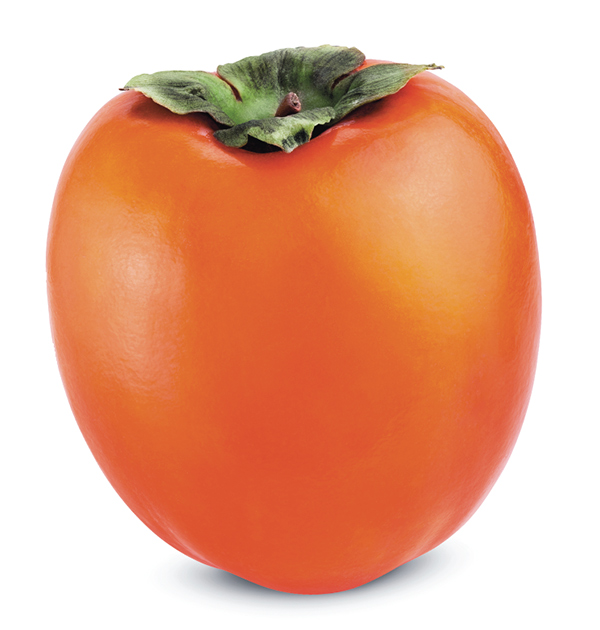
The hachiya is shaped like an acorn or a heart and won’t be sweet until it is as soft as an overripe tomato, with a jelly-like texture. Once off the vine, they will ripen in a few days or weeks.
You can eat a hachiya’s pulp with a spoon or use it in yogurt, oatmeal, ice cream, jam or smoothies or bake it into cookies, muffins and breads.
Either of the two main types will work for drying, but at least one farm that makes traditional Japanese dried persimmons, called hoshigaki, prefers astringent varieties.
“We like to use the hachiya and the giombo (traditionally ‘gyombo’) persimmons for hoshigaki,” says Chris Kuratomi, who co-owns Otow Orchard in Placer County with husband Tosh Kuratomi.
“We use those because we can peel them when they’re hard and then when they start to dry, the outside starts to get dry and leathery and then the inside starts to ripen and get soft and then they become very sweet,” she says.
“We have experimented with other varieties,” Tosh adds, but “we decided these two varieties had the sweetest flavor.”

